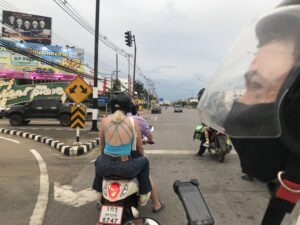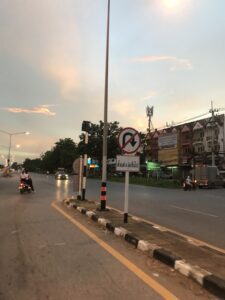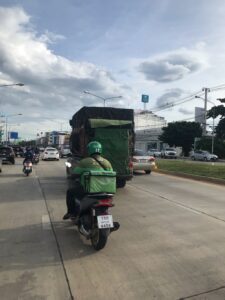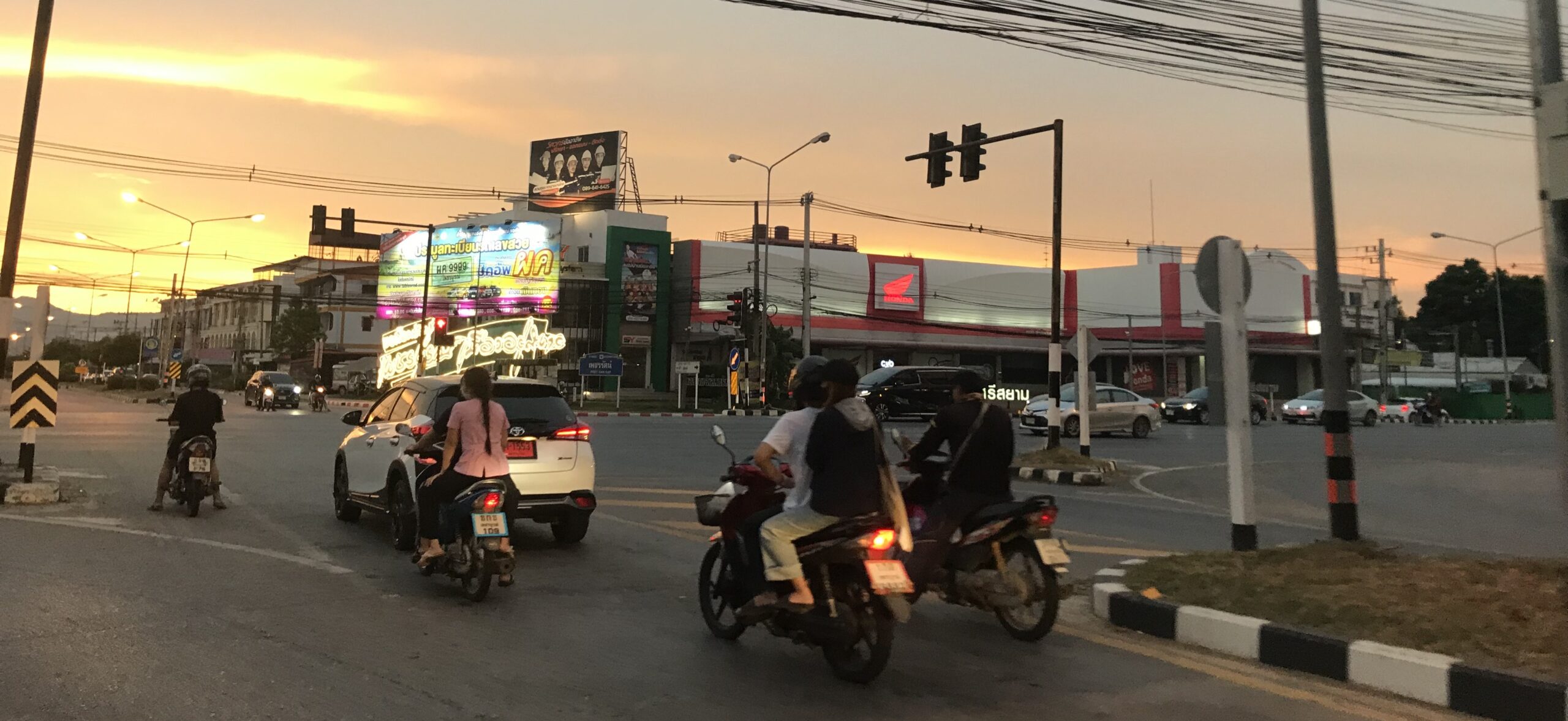By Amy McCadden, Teacher in Phetchabun, Thailand
Thailand is known for many things, like it’s good food, impeccable people skills, and less than impeccable roads. Anyone who has spent time in Bangkok will remember the heady rush of adrenaline you experience getting from point A to B. Yes, there are traffic lights, but at times these seem more like a guideline than a legal requirement. Just crossing the street to reach the meat cart of your dreams has you making peace with your life as a pre -requisite. At some point, you will be in either the passenger or driving seat of a vehicle, so you’ll need to be prepared for traversing the wild and wonderful traffic system. Tricky at first, but there’s an unimaginable sense of freedom to be found once you feel more comfortable on the roads, which you wouldn’t get from buses or taxis. This article is here to give you some top tips for getting out there and seeing a different side to Thailand. Though it is aimed at bikers, there are some general tips that anyone will find helpful.
Wear a Helmet
It feels almost redundant to put this one first, but it’s by far the most important point. Thailand’s roads are the ninth most dangerous in the world, and roughly two people are killed every hour. A driver is legally required to wear a helmet, but other passengers aren’t and every day I see up to three people on one bike without a single helmet. There are many reasons for this- firstly, it is a hard rule to enforce with the large number of vehicles on roads. Secondly, people will start riding from a young age, and they become adept at riding high speeds without the need for protective gear. This isn’t an issue, until they have an accident, and without a helmet the risk of dying or receiving a life-changing injury is much higher. The chances of an accident for an expat without any prior experience riding are even greater. Regardless of what you see locals doing, or even other tourists, it just isn’t worth it. Pop a helmet on, it will save your life.
Stick to the Left
 Thailand’s roads have an unofficial hierarchy; Trucks and lorries, cars, motorbikes, and much, much further down are cyclists and pedestrians. To avoid becoming a road pancake it is wise to stay away from larger vehicles as they are prone to changing lanes at short notice. There are two lanes of traffic and a smaller lefthand lane reserved for motorbikes. I’d highly recommend staying in the left lane as much as you can and keeping to a slower speed. Similarly, at traffic lights you have painfully long 90 seconds, so weaving your way to the front with the other bikes isn’t hard and keeps you in other vehicles sight.
Thailand’s roads have an unofficial hierarchy; Trucks and lorries, cars, motorbikes, and much, much further down are cyclists and pedestrians. To avoid becoming a road pancake it is wise to stay away from larger vehicles as they are prone to changing lanes at short notice. There are two lanes of traffic and a smaller lefthand lane reserved for motorbikes. I’d highly recommend staying in the left lane as much as you can and keeping to a slower speed. Similarly, at traffic lights you have painfully long 90 seconds, so weaving your way to the front with the other bikes isn’t hard and keeps you in other vehicles sight.
There is a proud culture of bikes here, which extends cheap and cheerful scooters all the way to Harley Davidson enthusiasts. It’s the main mode of transport for Thai people since it’s cheaper to run and quicker to get around. Whilst the majority drive safely, there are plenty who throw caution to the wind. It could be a foodpanda deliveryman on his way to feed the masses, or a grandma taking two children home from school. You will be baffled and surprised by the people who treats the roads as the Grand Prix.
Watching Out for Other Drivers
Vehicles coming up the wrong side of the road, bikers helping their friend’s bike that had broken down by pulling them alongside, cars going through red lights, in just over a month I have seen all manner of illegal (and highly entertaining) moves. Most drivers will not behave like this, but in a country with over a third on the road without proper qualifications, accidents happen frequently. Keeping an eye out for those around you is always important, but doubly so in Thailand. Your wing mirrors are your new best friends, as is your horn and turning lights- let people know if you come round a sharp corner, or cross a lane, and check behind before you turn a corner. Go slowly, and let others overtake you, you’re not in a hurry.
I would also recommend the Instagram page Thaisdoingthings for a glimpse into some otherworldly road behaviour. Very entertaining and likely the best representation of Thailand’s roads you’ll find. Enjoy!
Making U-Turns
Features of the UK roads, such as a roundabout, underpasses, and overpasses, are either few or non-existent. If you want to start driving in the other direction, you’ll have to make use of a U-turn, which is the main way to change direction. These can take a while to reach, however, so some drivers will simply drive on the wrong side of the road. Once you have avoided a head on collision and reached your U-turn spot, you may notice some have traffic lights, and during the morning rush hour you may see traffic police orchestrating the flow. Otherwise, it’s up to you to judge when the road is clear. The main issue is timing, since misjudging a u-turn will have you drive head on into a vehicle. Estimating the speed and distance of traffic is more difficult than you might think, and what seems a free space is littered with traffic you cannot see yet. If you’re unable to guarantee that the road is clear, just wait. Even if vehicles are creeping up behind you, just stay calm and focus on crossing when the coast is truly clear. Self-awareness is the best tool in your arsenal.
 Flashing Lights
Flashing Lights
This is a small but very important point. In the UK, when crossing a road or changing a lane, flashing your lights at someone is polite communication the driver is stopping and allowing you to cross/ pass. For Thai drivers, if they flash their lights at you, this is a warning of the opposite. They’re saying, ‘get out of my way, I’m not slowing down for you at all!’. It is helpful to learn this now than to perform a U-turn thinking that the oncoming car is stopping for you. I made this mistake crossing a road once and narrowly avoided being squashed, and now I take at least five minutes to cross a road every time. Better to be late than flat!
Why are the Roads the Way They Are?
So why, if Thailand is renowned for its excellent people skills and warm hospitality, does the road contradict this? There is a common phrase which can give us a small insight – Mai Pen Rai. Roughly translated to ‘it does not matter’, this refrain will be heard everywhere from your co-teachers to your local 7/11 staff. It promotes an easy-going approach to life. Someone cut you off in traffic? Mai pen rai. A kind stranger passes you the purse you just dropped? Mai Pen Rai. Thank the cashier in your local supermarket? Mai Pen Rai. During your time in Thailand, you may hear this often or not at all, it really depends on where you live and the people you meet, but it can be a useful guide to understanding the behaviour of people on the roads.
In conclusion, the main takeaway is that you should always exercise caution. Wear a helmet, keep out of the way of speeding drivers, and above all else- stay calm. Since road rage is not culturally tolerated, just remind yourself of the Thai motto- it’s all fine, it’s not a problem. You’ll relax into the driving, and soon see that travelling through Thailand like this provides access to breath-taking views and off-the-beaten-track spots without becoming one with the road.
Would you like to teach English in Thailand? Explore our program page or submit an application




